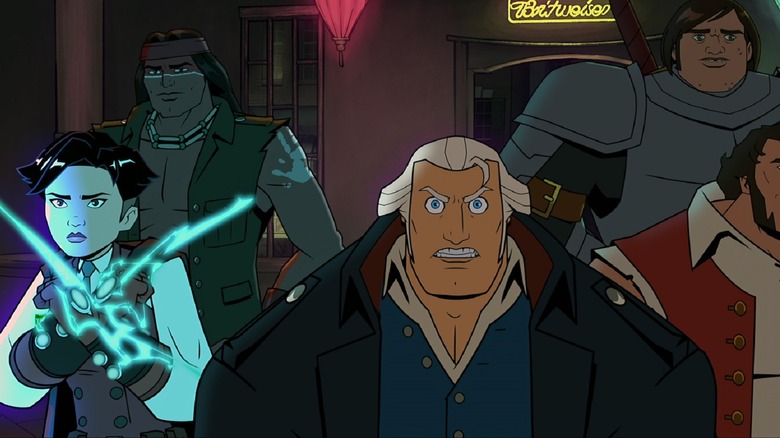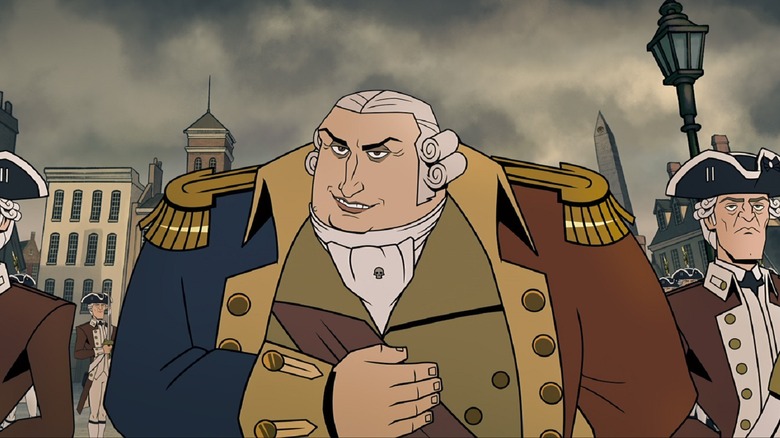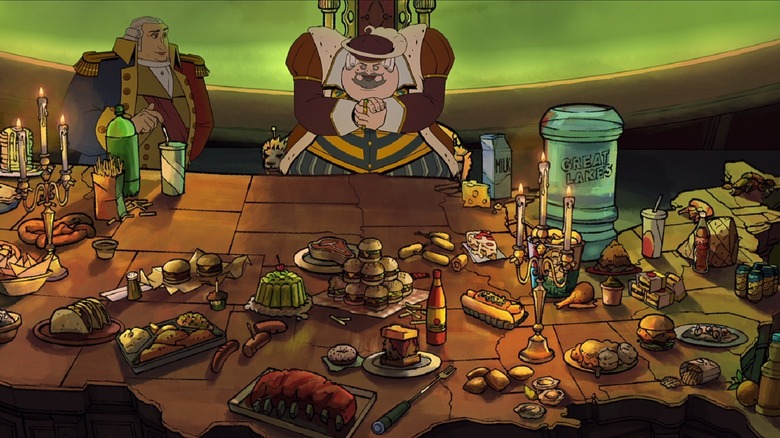Small Details You Missed In America: The Motion Picture
This content was paid for by Netflix and created by Looper.
The American Revolution gets a rip-roaring reimagination in the animated comedy "America: The Motion Picture." The film takes everything you know about U.S. history and throws it into a blender to create one action-packed adventure for the nation's founding fathers and mothers. Instead of using an axe to chop down cherry trees, this George Washington whips out chainsaw arms to mow down his enemies in King James' army; and rather than being motivated to fight for freedom by that fabled call for "no taxation without representation," he really just has a bone to pick with Benedict Arnold for betraying his best pal Abraham Lincoln.
While you won't find this version of America's foundational story in your textbooks, history buffs will still delight in scouting out the many, many real-life references scattered throughout the movie from both colonial and more contemporary events. Here are some of the small details you might have missed in "America: The Motion Picture."
Honest Abe loves the theater
Movie fans will find cinematic tributes everywhere in "America: The Motion Picture." One doesn't need bald eagle eyes to spot all of the blockbuster parodies mentioned at Ford's Theatre, for example — who wouldn't want to watch "Full Metal Musket" and "Snakes on a Carriage"? You'll also notice other puns about everything from "Transporter" to "John Wick" to "Ghost" sprinkled throughout the pic, and there's even a moment where the Brits fool the Americans into thinking they're hiding out at the Gettysburg address by using Kevin McAllister's clever mannequins-in-motion trick from "Home Alone." The final battle sequence is also basically a love letter to the best fight scenes from "The Empire Strikes Back" and "Avengers: Endgame."
But one of the more subtle winks to Hollywood comes near the end of the movie, when freedom finally rings, and the ghost of Abraham Lincoln shows up to return the Declaration of Independence to his now-victorious buddy George Washington. Abe then has to tell his old friend that no, there is not a treasure map hidden on the back of the tattered document — and even though the movie title isn't mentioned, it's clear the "National Treasure" franchise has fooled everyone in the 18th Century, too.
It's only fitting that this Nicolas Cage classic should earn this well-placed wink in the film, of course. You simply cannot make a revisionist history movie involving the theft of the Declaration of Independence without showing some love to the blockbuster that still has the U.S. National Archives shutting down treasure map theorists a decade and a half later. That didn't make it into King James' list of rules, but it should have.
A hodgepodge of heroes
You might want to pause "America: The Motion Picture" to do some crowd-spotting at certain moments throughout the film. That's because, in addition to the cavalcade of historical heroes that carry the action, there are also some very familiar faces thrown into the background of certain scenes. Abe's funeral in particular is essentially a who's who of American icons, with quick shots of folks like the Roosevelt cousins, JFK and Marilyn Monroe, Lucille Ball, and Lin-Manuel Miranda playing Alexander Hamilton in "Hamilton."
Included in these cartoon cameos is one of the most hilarious sight gags of the entire film, as we see baby John Quincy Adams snuggled up in his mother Abigail's arms while she grieves next to her husband John Adams. Only, instead of the usual cherubic cheeks you'd likely see on a kid John Q.'s age, this little tyke is shown sporting a fully silver mane with facial hair just like the one seen in his presidential portrait.
For most students of American history, it's probably hard to imagine the nation's sixth president as anything but the stern statesman depicted in his official paintings. And since parents didn't have cell phone cameras to document their babies' every step back in the colonial era, there's nothing to prove John Quincy Adams wasn't born with a set of mutton chops. For all we know, this could be the most accurate depiction of the second President Adams in his youth yet.
The problems of yore
While the crux of "America: The Motion Picture" is George Washington's ragtag team — Sam Adams, Thomas Edison, Geronimo, Blacksmith, and Paul Revere — trying to defeat the werewolf Benedict Arnold and King James and finally do some democracy, their adventures introduce some very tongue-in-cheek commentary about the longer-term problems their country will face.
Misogyny, racism, xenophobia, anti-science bias, and frat bros who call themselves "dicks" (per their ΔIX shirts) are just some of the scourges of society that they encounter but most definitely do not fix. There are also several scathing reminders of how lax gun sense regulations are — the waiting period for a truck full of rifles at the local Yall-Mart is next to nil — and after seeing these problems unfold on a small scale, even George Washington is convinced, "Oh God, we're going to f*** this up, aren't we?"
One of the timeliest jokes about the American experiment comes when Blacksmith talks to Geronimo about one of their companions claiming to have won the Vietnam War. "Can you imagine being so used to winning at everything for your whole life that even when you lose you're probably like, 'Yo, we must have won that sh**, right?' That's the definition of privilege right there," Blacksmith says. The context of his comment notwithstanding, that note could probably apply to plenty of more current events in American politics.


